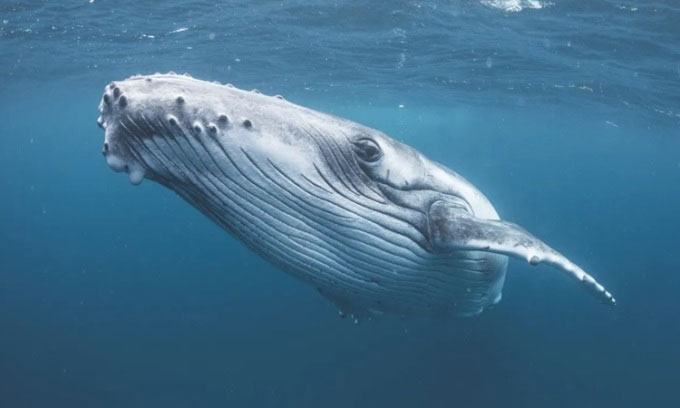Whale sets record by swimming across 3 oceans to find a mate
A male humpback whale (Megaptera novaeangliae) swam 13,046km from the Pacific Ocean to the Indian Ocean to increase its chances of mating, setting a new migration record.
The whale's journey was the longest circumpolar distance ever recorded for the species. A circumpolar distance is the shortest distance between two points on Earth measured on the planet's spherical surface. Beginning off the coast of Colombia in the eastern Pacific Ocean and ending off Zanzibar in the southwestern Indian Ocean, the whale's journey spanned 13,046 kilometers (8,100 miles) across the globe.

Humpback whales can grow up to 18 meters long and weigh 40 tons. (Photo: Mike Korostelev)
The humpback whales likely swam east from Colombia, riding the Southern Ocean currents and potentially meeting up with whale populations in the Atlantic, according to Ted Cheeseman, a PhD student at Southern Cross University in Australia and director of Happywhale, the image database the team used to collect evidence.
'It was such an exciting find that our first reaction was that there had to be something wrong,' Cheeseman said. Along with the incredible distance, one of the most important findings from the study was that the whale visited several humpback whale colonies along the way.
Humpback whales generally follow a consistent migration pattern , moving between feeding grounds in colder waters near the poles and breeding grounds closer to the tropics. They can swim more than 8,000 km north-south each year, but do not typically travel far east-west and do not mix with other populations.
The transoceanic journey the team observed suggests that humpback whale migration is more complex than previously thought. While scientists have occasionally recorded similar migrations, such as a female humpback whale swimming 6,000 miles from Brazil to Madagascar between 1999 and 2001, the male in the new study set a record for the distance traveled between one breeding site and another, said team leader Ekaterina Kalashnikova, a biologist with the Tanzania Whale Program and the Barazuto Scientific Research Center in Mozambique.
The findings, published Dec. 10 in the journal Royal Society Open Science, are based on photographs taken by researchers between 2013 and 2022. The images show the adult male whale appearing at two locations off the coast of Colombia and five years later in the Strait of Zanzibar, each time with a competing group (including a female whale closely guarded by a dominant male and several other males trying to approach her), according to Kalashnikova.
The motivation for the journey may be mating , with the male whale looking to increase his chances of reproducing by mingling with members of other populations. Other reasons behind his unusual journey may be related to environmental changes affecting food distribution, climate change and population growth leading to increased competition between males.
- Search for the whale 'Forever Alone' most on Earth
- The secret of swimming pool water contains toxins
- Two whale skeletons in Ly Son set record as largest in Vietnam
- Close up of the largest 170 ton blue whale on the planet
- Swimming pools help fishermen break world records
- Heartbreaking image of the death of blue whale
- Kissing a lot helps find suitable partners
- How do you weigh a 190 ton whale swimming at sea?
- The ocean heats up the equivalent of each person opening 100 microwaves
- The monkey crossed 9,600km to find a mate
- Find out what causes eye pain when swimming
- Smell to find a mate
 Surprised: Fish that live in the dark ocean still see colors
Surprised: Fish that live in the dark ocean still see colors Japan suddenly caught the creature that caused the earthquake in the legend
Japan suddenly caught the creature that caused the earthquake in the legend A series of gray whale carcasses washed ashore on California's coast
A series of gray whale carcasses washed ashore on California's coast Compare the size of shark species in the world
Compare the size of shark species in the world